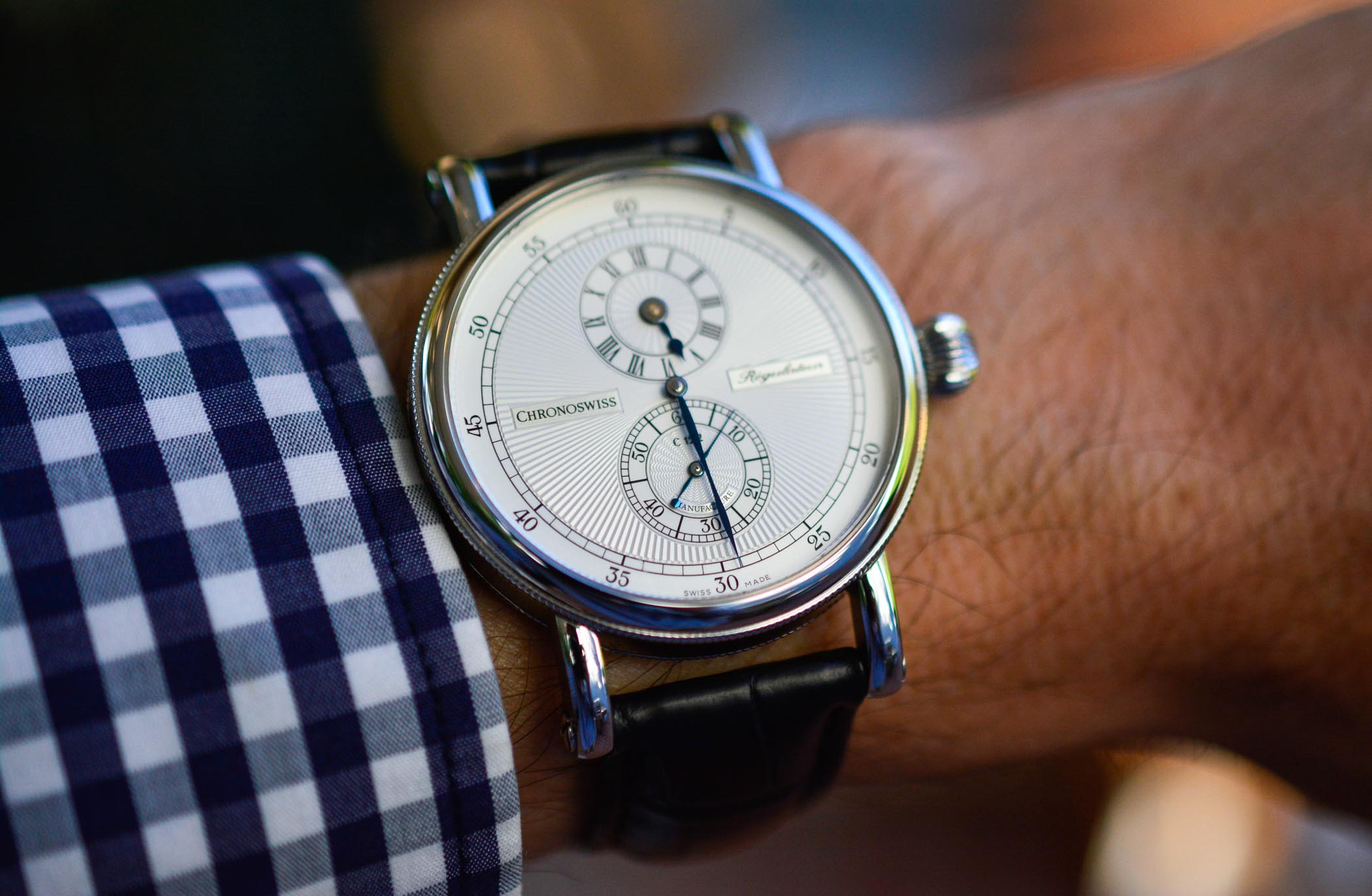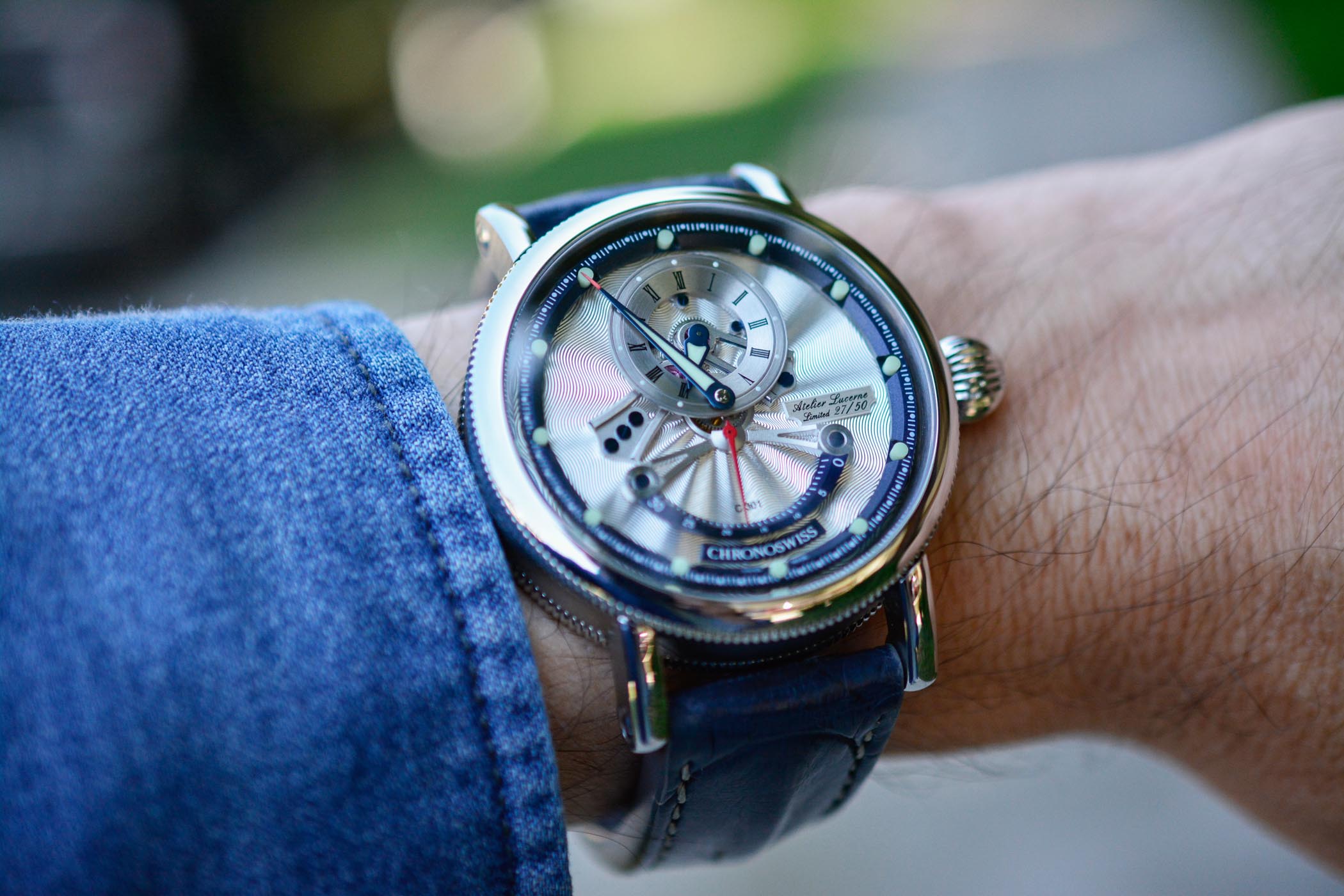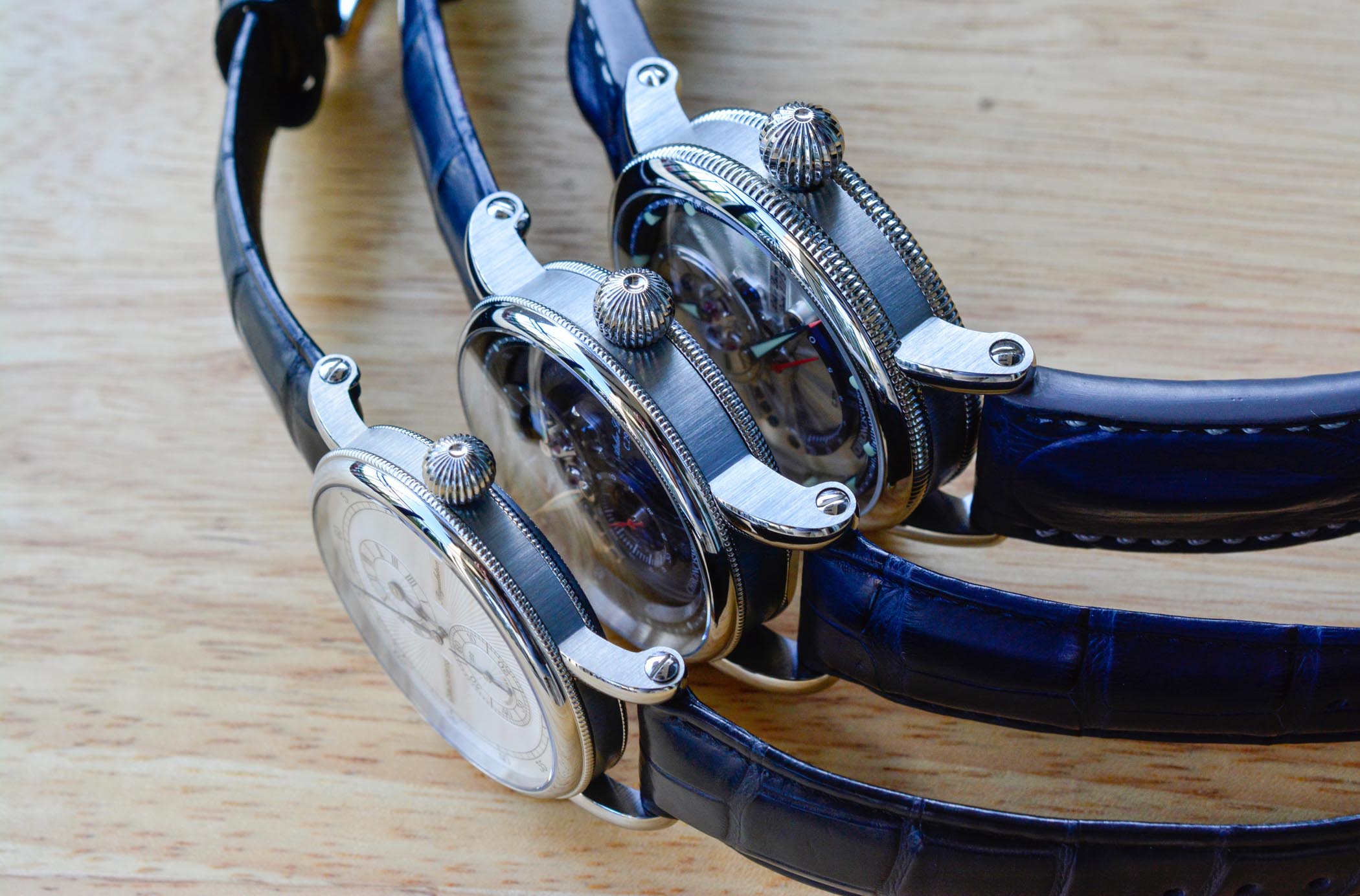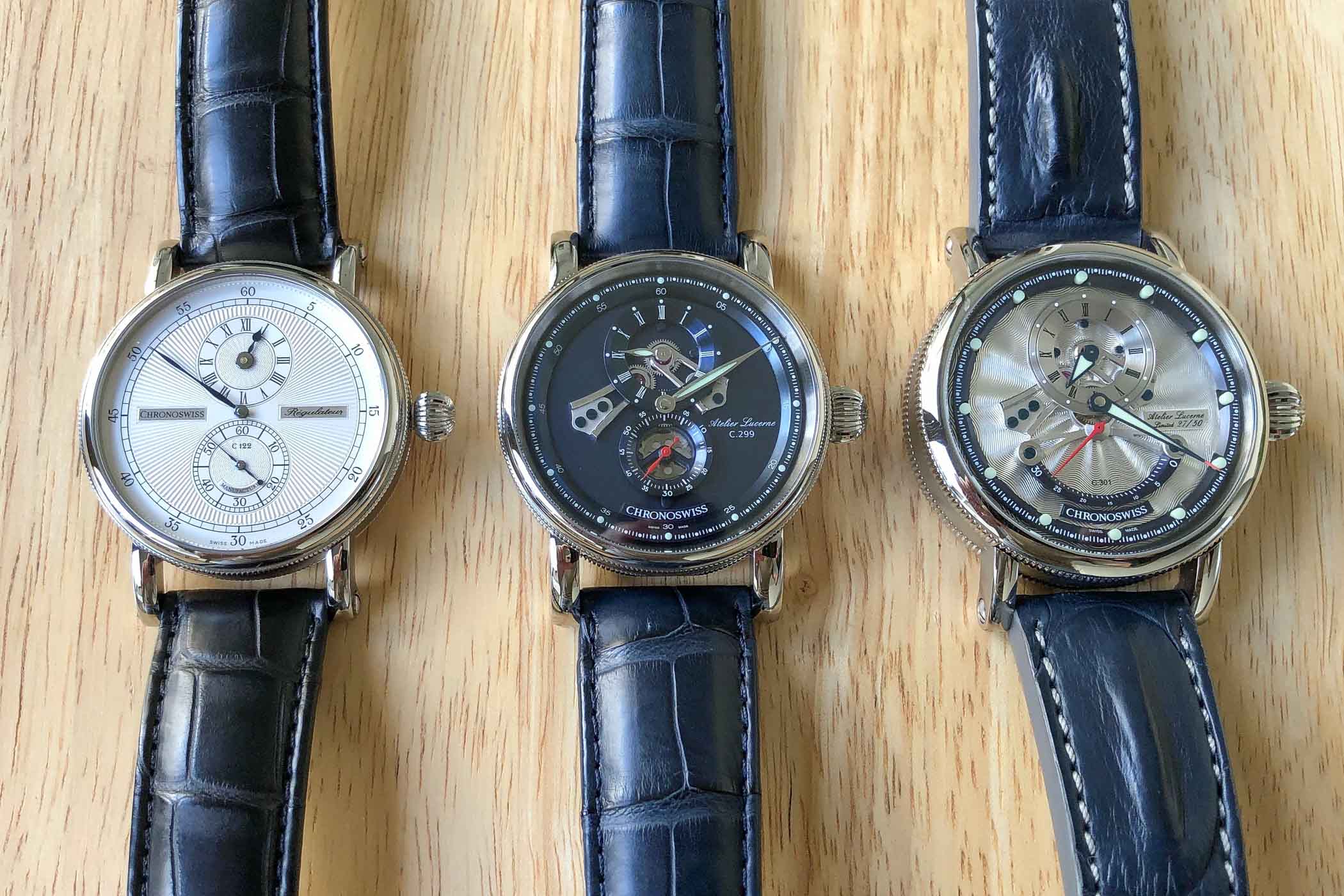The Evolution of the Regulator Watch by Chronoswiss
A Look at Three Distinct Models that Demonstrate the Progression of an Original Classic to Contemporary Interpretations.

Chronoswiss and regulators are synonymous these days. The company was the first to introduce this style on production wristwatches back in 1987 and has built a brand identity around it. That’s not to say that three-hand and chronograph pieces don’t exist (they’re alive and well in the Sirius and Timemaster collections), but regulators have become such a specialty that the others are often overshadowed. Not resting on its laurels, Chronoswiss has modernized the style with multi-dimensional and complex dials, skeletonization and advanced complications. Today we’re taking a closer look at Chronoswiss and the evolution of the regulator watch.
The regulator is the signature complication that defines Chronoswiss, and that makes this brand unique.
Many pieces in Chronoswiss collection bring an almost futuristic aesthetic to a design that debuted hundreds of years ago in master clocks that allowed pocket watchmakers to quickly set their timepieces. The concept is very simple – the hour, minute and seconds hands are separated into individual registers with the minute hand large and centralised. The hour and seconds hands were considered irrelevant for quick reference and simply moved out of the way. It can take a little getting used to when first strapping on a regulator, but the unique display has its merits (and looks cool) and I often prefer it over more conventional arrangements.
Although the brand has a wide variety of regulator models in its portfolio, three distinct pieces demonstrate its evolution best. We had the Regulator Manufacture, Flying Regulator Open Gear and Flying Grand Regulator Open Gear ReSec on hand, so let’s take a closer look at how Chronoswiss has contemporized an age-old concept over the last three decades.
A Quick Overview
Chronoswiss was founded in 1983 by Gerd R. Lang in Munich, Germany and is a relatively young brand of only 36 years. Lang had accrued extensive experience building movements for other brands and hit the ground running with his new company. Initial watches included the Opus, the first skeletonized chronograph, and tourbillon and quarter repeater models. It was the regulators, however, that truly defined the brand since their debut in 1987. Regulator wristwatches did exist prior to this (although very rare), but Chronoswiss was the first to produce them in series.

The style can be considered obsolete today as technology has replaced mechanical regulator clocks (atomic clocks are accurate to about one second every 300 million years or so, not to mention cheap quartz tech), but art often trumps science. Swiss entrepreneur Oliver Ebstein bought the company in 2012 and moved its headquarters to Lucerne, Switzerland. The acquisition didn’t alter the direction of the company, however, whose limited production watches retain many of the same hand-finished aesthetics of the early Munich days. Ebstein truly maintained the heart and soul of the brand and introduced a “House of Chronoswiss” inside the headquarters for visitors to see specialized techniques such as high-fire enamelling and engine turning (guilloché). The company remains independent today.
Chronoswiss Regulator Manufacture – Successor to the Original Régulateur
The original Chronoswiss regulator was the Régulateur, a classically designed piece with a 38mm stainless steel or rose gold case and two identical sub-dials flanking a centralized minute hand. Hours were at the top with seconds at the bottom and everything fell in a vertical arrangement. The initial models had a hand-wound movement but were soon replaced with the Chronoswiss C. 122 calibre, based on the Enicar 165 automatic.

Beyond the regulator setup, several features also stood out as distinctly Chronoswiss: knurled edges at the top and bottom of the case, oversized onion crown and large, sloping lugs with exposed screws. These features are still present today and a Chronoswiss piece is easily recognizable across a room by the external design elements alone. The Régulateur helped differentiate the brand as the industry was recovering from the quartz crisis and the company’s decision to fully embrace the style has paid off.
Today’s Regulator Manufacture is a direct follow-up to the Régulateur and remains faithful in design, but a few key things have changed. The main difference involves the dial, which has adopted intricate, guilloché patterns within the central section and sub-dials. The Régulateur dial had a simpler, matte finish. The knurled pattern spanning the case has abandoned the bezel and appears on the case band as a narrow ring (top and bottom). The original piece had a bolder, fully knurled bezel, while the new one is smooth and polished. The iconic onion crown is larger and more bulbous on the Manufacture, with a distinct yet more discreet crown adorning the older Régulateur.
The differences may sound big on paper, but the Regulator Manufacture is actually very close aesthetically and maintains the classic, simple sophistication of its older brother. Later pieces like the Regulator Classic Date have comparably straightforward designs but lack the traditional symmetry and direct lineage.
The Regulator Manufacture has a larger 40mm case (notwithstanding older special editions) but isn’t too far off from the original’s 38mm. It’s offered in stainless steel or 18K gold with satin and polished elements, and the familiar knurled rings surrounding the ends. Returning to the dial, it’s a sterling silver affair with two engine-turned patterns. The central section sports a sunray pattern and the two sub-dials have a wave pattern, and they add a classic touch that the original lacked. Guilloché started in the late 18th century on watch dials and is generally credited to Breguet. The patterns on the Manufacture certainly don’t contemporize anything as they can be considered “old fashioned” and the dial is virtually unchanged otherwise. The thermally blued steel hands are also unchanged with a Poire Stuart style (kind of a spade style for the hours and leaf for the rest).
The Calibre C. 122 automatic has endured (again based on the Enicar 165) and offers a restrained, well-finished appearance through the exhibition caseback. The movement is decorated with perlage and Côtes de Genève, and the rotor is customized and open-worked. It features 30 jewels, beats at 21,600vph (3Hz) with a 40-hour power reserve, and an in-house designed and produced module is employed for the regulator setup. Newer models have ETA-based movements and the Calibre C. 122 solidifies the Manufacture as a twin to the Régulateur, albeit with a slightly nicer suit.
Chronoswiss Flying Regulator Open Gear – Welcome to the 21st Century
There have been variants of the Chronoswiss regulator during the brand’s first three decades of life, but all have remained relatively simple, one-dimensional pieces. That all changed in 2016 when the brand shocked the industry with a futuristic, reimagining of the style. The new dial was now three-dimensional with exposed gears, bridges and jewels, and an overall architecture never seen before. This “old” style was suddenly fresh and new again, and positively 21st century in design. The design itself was horologically interesting and brought additional appeal to enthusiasts and collectors, above and beyond the already desirable regulator setup. It was a shot of adrenaline that signalled a new direction for the line, while still maintaining familiar traits that the brand is famous for.
The sub-dials were now funnel-shaped with a lot of depth, and the top hour sub-dial was much larger than the bottom seconds. Underneath that hour register were exposed gears connected to two separate bridges, showcasing mechanical interaction usually hidden under the dial. The bridge on the left had a transfer gear connecting to both the hour (top) and minute (centre) hands, and both bridges were angled and polished. Oversized jewels were also displayed under them, larger than normal for aesthetic impact. The seconds sub-dial featured a partially skeletonized view of the regulator module, showing even more depth as the funnel dipped below the main dial and into the mechanism. The chapter ring was basically a large funnel itself, sloping down from the perimeter with Arabic numerals printed every five minutes on the inner wall. Both the sub-dials and bridges were mounted to the lower main dial with blued screws, which was galvanized silver without guilloché patterns. The minutes hand was again central and prominent, and all hands had a leaf style with Super-LumiNova inlays on the hours and minutes. The Flying Regulator Open Gear is aptly named as elements seem to be floating above the dial with exposed mechanics underneath.
While the updated design was a world away from the classic Regulator Manufacture, not everything had changed. The case grew only slightly to 41mm in diameter, again with stainless steel and 18k gold options. The signature onion crown and knurled edges returned, as did the large, sloping lugs with exposed screws, keeping it very recognizable as a Chronoswiss piece. The crown was a bit larger this time, along with the bottom knurled edge, but those changes were subtle. The movement was upgraded to the Caliber C. 299 automatic, now based on an ETA 2895. As with the Manufacture, an in-house designed and produced regulator module sits above the movement. It has 31 jewels, beats at a faster 28,800vph (4Hz) with a 42-hour power reserve. Viewed from the exhibition caseback, it features perlage and a custom open-worked rotor, but not Côtes de Genève as seen on the Calibre C. 122.
Many variants of the Flying Regulator Open Gear exist within the line, including four standard options (one gold and three stainless steel) and limited models like the 35th Anniversary Edition with new colour schemes and a complex guilloché pattern, and themed cryptocurrency models. For example, the Bitcoin watch has a Bitcoin logo over the seconds sub-dial and throughout the main dial and a black and gold colour palette. Things change a bit with the Flying Regulator Night and Day that adds an arched date window at 3 o’clock (three digits displayed at once) and a Night and Day indicator. The latter complication features a 3D-blued titanium globe with laser-cut stars for the night, filled with bright Super-LumiNova.
To accommodate the complications, the two large bridges of the original Flying Regulator have been replaced with four smaller ones, and the exposed gears under the hour sub-dial have been removed (the open seconds sub-dial remains). Additional variations like the Flying Grand Regulator Skeleton Limited Edition bring an even more futuristic aesthetic with skeletonization as the Flying Regulator Open Gear proved to be a game changer for Chronoswiss and a new base to build on.
Chronoswiss Flying Grand Regulator Open Gear ReSec – Retrograde Seconds and a Return to Guilloché
Complications have been added to the Flying Regulator Open Gear base as the aforementioned Flying Regulator Night and Day shows, but only one other has directly impacted the regulator setup itself (the Flying Regulator Jumping Hour replaced the hour sub-dial with a jumping hour complication). The Flying Grand Regulator Open Gear ReSec focuses on the seconds this time, replacing the standard seconds sub-dial with a large retrograde seconds indicator. The retrograde seconds consists of a hand sweeping across a 120-degree arc of 30-second markers, instantly bouncing back to the start to sweep the next thirty seconds. It adds an interesting dynamic to the Flying Regulator design and reminds me of an old-school typewriter carriage (or inverted windshield wiper). Retrograde mechanisms were again developed by Breguet in the late 18th century and this current application is flashy, cool and definitely unique. As with the previous models, familiar elements remain, but this piece again opens the door to new interpretations of what a Chronoswiss regulator can be.
Looking at what hasn’t changed, the case is again offered in stainless steel (with DLC-coating options) and 18k gold. The knurled edges are larger and more prominent this time, but the bezel is still smooth and polished as before. The onion crown has also grown, now even larger than the Flying Regulator Open Gear and it dwarfs the Regulator Manufacture. These changes are a result of the case itself growing substantially to 44mm in diameter (with a hefty 13.35mm height), which makes a real statement on the wrist (and a challenge to slip under a cuff). A classic piece this is not.
The exposed twin bridges, gears and jewels from the standard Open Gear’s hour sub-dial are intact, but the exposed section at the bottom is gone. The funnel-like chapter ring is similar to the Open Gear, but with much larger applied luminescent insets every five minutes. The main base dial takes inspiration from the classic Manufacture with a return to guilloché, but the engine-turning is more complex. A three-dimensional “solar” pattern flows around the dial, enhancing the 3D aesthetic while adding a hand-worked flamboyance. The dial is comprised of 42 parts and is a big step up from the already well-executed Manufacture and Open Gear, and gives the piece a bit of gravitas. The thermally blued and polished hands (or lacquered) have an in-house designed “Trigono” style, again with Super-LumiNova inlays in the hours and minutes. A small plaque sits at 3 o’clock on the dial to indicate the individual limited edition number of 50 pieces.
The upgraded Calibre C. 301 drives the Flying Grand Regulator Open Gear ReSec, again based on the ETA 2895. An in-house developed and produced retrograde seconds mechanism accompanies the regulator module, making this the most complex movement of the three base models. It has 33 jewels, beats at 28,800vph (4Hz) with a 42-hour power reserve. Similar to the Manufacture’s Caliber C. 122 when viewed from the exhibition caseback, it’s decorated with both perlage and Côtes de Genève, and also has a colour matching custom open-worked rotor.
Final Thoughts
Following the company’s debut of the Régulateur, many regulators have hit the scene in a wide variety of flavours. Pre-eminent luxury brands have dabbled with pieces like the Patek Philippe Annual Calendar Regulator, Breguet Classique Regulator, Vacheron Constantin Maitre Cabinotier Perpetual Calendar Regulator and A. Lange & Söhne Richard Lange Jumping Seconds. More affordable options from Hamilton, Tissot, Oris and more are also popular. There have been fun and quirky pieces like the Hamilton Jazzmaster Regulator Cinema with miniature film reels replacing traditional sub-dials and the Garrick Regulator with a bright engine-turned dial and a large, exposed balance wheel. All of the above are exceptions to the rule, however, as they represent a small fraction of their respective brand’s portfolios. Chronoswiss, on the other hand, is all about regulators with an extensive collection.
It’s great to see the Regulator Manufacture still a part of Chronoswiss as such a classic design never goes out of style. It’s also the closest thing we have to the original. But time inevitably marches on and contemporary evolutions were necessary to stay ahead of the pack. The Flying Regulator Open Gear both revolutionized the style and set a new base to build on, bringing about interesting variations and the bolder Flying Grand Regulator series. The Flying Grand Regulator Open Gear ReSec wasn’t the first to alter the traditional regulator set-up but combines a new, advanced complication with the Flying Regulator base to further explore how the style can evolve. Imagine a regulator with a jumping hour and retrograde seconds. No other brand has shown such a commitment to regulator wristwatches and holding the classic Manufacture next to the Open Gear ReSec really demonstrates how far Chronoswiss has come.
Without this decades-long commitment and bold experiments in design, the regulator style may have simply languished as a curiosity for brands to toy with. I, for one, am grateful to Chronoswiss for not only embracing the style but keeping it exciting by reimagining the regulator as contemporary, 21st-century functional art. Prices for watches featured in this article start at CHF 6,100, which certainly isn’t cheap, but very reasonable for such intricately designed, limited production pieces with in-house modules and complications. And if you’re looking to acquire a regulator, no one does it better. For more information or to make a purchase, visit the Chronoswiss website or participating retailers worldwide.
























1 response
If you look at these things as a kinetic bracelet rather than a watch they are quite interesting.